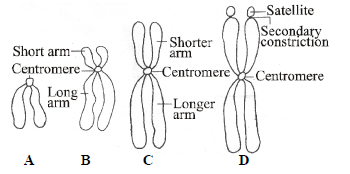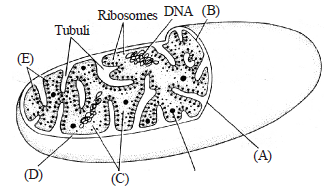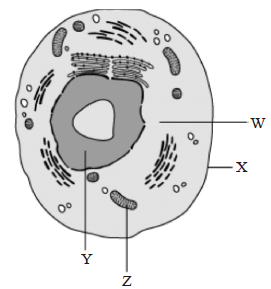Please see Chapter 8 Cell The Unit of Life Exam Questions Class 11 Biology below. These important questions with solutions have been prepared based on the latest examination guidelines and syllabus issued by CBSE, NCERT, and KVS. We have provided Class 11 Biology Exam Questions and answers for all chapters in your NCERT Book for Class 11 Biology. These solved problems for Cell The Unit of Life in Class 11 Biology will help you to score more marks in upcoming examinations.
Exam Questions Chapter 8 Cell The Unit of Life Class 11 Biology
Objective Questions
Question. Of the following structures of plant cell, the one that most often has greatest volume is
(a) Vacuole
(b) Lysosome
(c) Glyoxysome
(d) Ribosome
Answer
A
Question. Which one is correct statement?
(a) In amoeba contractile vacuole is important for excretion and osmoregulation
(b) In many cells as in protists, food vacuoles are formed by engulfing the food particles
(c) Both (a) and (b)
(d) Vacuole is always large sized in all cells of plant
Answer
C
Question. The DNA is located in the _____ of _____
(a) Cisternae, mitochondria
(b) Matrix, mitochondria
(c) Intermembrane space, mitochondria
(d) Grana, chloroplast
Answer
B
Question. Which of the following organelles are double bound?
(a) Nucleus
(b) Chloroplast
(c) Mitochondria
(d) All
Answer
D
Question. Both the membrane of mitochondria are
(a) Structurally different but functionally similar
(b) Structurally as well as functionally similar
(c) Structurally similar but functionally different
(d) Structurally and functionally different
Answer
D
Question. The matrix of which cell organelle has single circular DNA molecule, a few RNA, 70s ribosomes and components required for protein synthesis band aerobic respiration
(a) Chloroplast
(b) Golgi body
(c) Mitochondrion
(d) ER
Answer
C
Question. Plastids are found in
(a) All animal cells
(b) Some animal cells
(c) All plant cells
(d) All plant cells and euglenoids
Answer
D
Question. Based upon the type of pigment, plastids are of how many type?
(a) 3 types
(b) 4 types
(c) 2 types
(d) 5 types
Answer
A
Question. Function of RER is
(a) autolysis
(b) protein synthesis
(c) lipid synthesis
(d) carbohydrate synthesis
Answer
B
Question. _______________ is the important site of formation of glycoproteins and golycolipids.
(a) SER
(b) Lysosome
(c) Golgi apparatus
(d) Mitochondria
Answer
C
Question. Lysosomes contain
(a) carbohydrates
(b) hormones
(c) nucleic acids
(d) hydrolases.
Answer
D
Question. Both the membranes of mitochondrion are
(a) structurally different but functionally similar.
(b) structurally as well as functionally different.
(c) structurally similar but functionally different.
(d) structurally different but functionally similar.
Answer
B
Question. Plastids storing fat are called
(a) Elaioplasts
(b) Sphaerosomes
(c) Aleuroplasts
(d) Pyrenoids
Answer
A
Question. A component of cytoskeleton is
(a) microtubule
(b) bone
(c) chitin
(d) cartilage.
Answer
A
Question. Axoneme with 9 + 2 microtubular arrangement occurs in
(a) cilia
(b) flagella
(c) both (a) and (b)
(d) centriole
Answer
C
Question. Basal bodies are associated with the formation of
(a) phragmoplast
(b) cilia and flagella
(c) cell plate
(d) kinetochore
Answer
B
Question. Nucleolus is
(a) rounded structure found in cytoplasm near nucleus.
(b) rounded structure inside nucleus and having rRNA.
(c) rod-shaped structure in cytoplasm near the nucleus.
(d) none of the above.
Answer
B
Question. Chromosomes having equal or almost equal arms are called
(a) metacentric
(b) acrocentric
(c) polycentric
(d) acentric.
Answer
A
Statement Type Questions
Question. Select the incorrect statement about prokaryotic ribosomes.
(a) 50S and 30S subunits unite to form 70S ribosomes.
(b) Polysome/polyribosome consists of many ribosomes only.
(c) Ribosome is the site of protein synthesis.
(d) Polysome indicate the synthesis of identical poolypeptide in multiple copies.
Answer
B
Question. Which of the following statements is/are correct ?
(i) The shape of the cells may vary with the function they perform.
(ii) Human RBC is about 7.0 mm in diameter.
(iii) Cytoplasm is the main area of cellular activities.
(iv) Various chemical reactions occur in cytoplasm to keep the cell in the living state.
(a) (i), (ii), (iii) and (iv)
(b) Only (i) and (ii)
(c) Only (iv)
(d) None of the above
Answer
A
Question. Which of the following is not the function of cell wall?
(i) Provides shape to the cell.
(ii) Protects the cell from mechanical damage and infection.
(iii) Helps in cell to cell interaction.
(iv) Provides barrier to undesirable macromolecules.
(a) Only (i)
(b) Only (iv)
(c) Only (ii), (iii) and (iv)
(d) None of the above
Answer
D
Question. Which of the following statements are incorrect ?
(i) Plant cells have centrioles which are absent in almost all animal cells.
(ii) Ribosomes are the site of protein synthesis.
(iii) The middle lamella is a layer mainly of calcium carbonate which holds the different neighbouring
cells together.
(iv) In animal cell, steroidal hormones are synthesized by smooth endoplasmic reticulum.
Of the above statements
(a) (i) and (iii)
(b) (iii) and (iv)
(c) (ii) and (iv)
(d) (i) and (iv)
Answer
A
Question. Choose the wrong statements regarding bacterial cell
(i) Glycocalyx is the outermost envelope in bacteria.
(ii) The glycocalyx could be a loose sheath called capsule.
(iii) The glycocalyx may be thick and tough called slime layer.
(iv) A special structure formed by the plasma membrane is called mesosome.
(v) Small bristle like fibres sprouting out of the cell are called fimbriae.
(a) (i) and (iii)
(b) (i) and (ii)
(c) (ii) and (iii)
(d) (i) and (iv)
Answer
C
Question. Consider the following statements and choose the correct statement.
(i) The endomembrane system includes mitochondria, chloroplast and peroxisomes.
(ii) Smooth endoplasmic reticulum is the major site for synthesis of lipid.
(iii) Rough endoplasmic reticulum is actively involved in protein synthesis.
(iv) Mitochondrial matrix possesses single circular DNA, a few RNA and 80S ribosomes.
Of the above statements.
(a) (i) and (iii)
(b) (ii) and (iv)
(c) (iii) and (iv)
(d) (ii) and (iii)
Answer
D
Question. Read the statements given below with regard to the functions performed by Golgi apparatus ?
(i) Transport and chemically modify the materials contained within it.
(ii) Performs the function of packaging materials.
(iii) Important site of formation of glycoproteins and glycolipids.
Which of the following is the correct answer ?
(a) (i) is wrong but (ii) and (iii) are correct
(b) (ii) is wrong but (i) and (iii) are correct
(c) (ii) and (iii) are wrong but (i) is correct
(d) All are correct.
Answer
D
Assertion/Reason Type Questions
In the following questions, a statement of Assertion is followed by a statement of Reason.
(a) If both Assertion and Reason are true and the Reason is the correct explanation of the Assertion.
(b) If both Assertion and Reason are true but the Reason is not the correct explanation of the Assertion.
(c) If Assertion is true but Reason is false.
(d) If both Assertion and Reason are false.
Question. Assertion : Cells vary greatly in their shape.
Reason : The shape of cell does not depend on the function they perform.
Answer
C
Question. Assertion : The acrocentric chromosome has centromere at the terminal position.
Reason : The metacentric chromosome has centromere slightly away from the middle of the chromosome.
Answer
D
Question. Assertion : Pili are nonmotile appendages of bacteria.
Reason : Pili take part in conjugation.
Answer
B
Matching Type Questions
Question. Which of the following pair are correctly matched?
A. Microtubules – Structural components of cilia
B. Centrioles – Store hydrolytic enzymes
C. Amyloplasts – Store oil protein and starch in plants
(a) A, B and C
(b) A and B
(c) A only
(d) A and C
Answer
C
Question. Which one of the following combination is mismatched?
(a) Glycocalyx – May be capsule or slime layer
(b) Pili – Reproduction
(c) Cell wall – Protective, determines shape, prevents from bursting
(d) Flagella, pili and fimbriae – Surface structures of bacterial cell
Answer
B
Question. Which one of the following pairs is NOT correctly matched?
(a) Cristae – The tubular structure formed by the folding of the inner membrane of the mitochondrion.
(b) Plasmodesmata – The membrane surrounding the vacuole in plants.
(c) Grana – Membrane bound discs in chloroplasts that contain chlorophylls and carotenoids.
(d) Middle lamella – Layer between adjacent cells walls in plants derived from cell plate.
Answer
B
Question. Which one of the following cellular parts is correctly matched with their characters ?
(a) Centrioles – Sites for active RNA synthesis.
(b) Lysosomes – Optimally active at a pH of about 8.5.
(c) Thylakoids – Flattened membranous sacs forming the grana of chloroplasts.
(d) Ribosomes – Those on chloroplasts are larger (80S) while those in the cytoplasm are smaller (70S).
Answer
C
Question. Which of the following terms is NOT correctly matched with its feature?
(a) Osmosis – Movement of water by diffusion.
(b) Nucleoplasm – Site of active synthesis of ribosomal RNA.
(c) Mesosome – Infolding of cell membrane and characteristics of eukaryotes.
(d) Pili – Elongated tubular surface structures (made of special protein) of bacteria.
Answer
C
Critical Thinking Type Questions
Question. pH of vacuolar cell sap is
(a) neutral and isotonic.
(b) alkaline and isotonic.
(c) acidic and hypertonic.
(d) equal to cytoplasm and isotonic.
Answer
C
Question. The main organelle involved in modification and routing of newly synthesized proteins to their destinations is
(a) chloroplast
(b) mitochondria
(c) lysosome
(d) endoplasmic reticulum
Answer
D
Question. Microtubules, motor proteins, and actin filaments are all part of the
(a) mechanism of photosynthesis that occurs in chloroplasts.
(b) rough ER in prokaryotic cells.
(c) cytoskeleton of eukaryotic cells.
(d) process that moves small molecules across cell membranes.
Answer
C
Question. The best way to identify a cell as either prokaryotic or eukaryotic is to determine whether
(a) it came from a single-celled or multicellular organism.
(b) it has a nucleus.
(c) it has a plasma membrane.
(d) it has cytosol.
Answer
A
Question. Centrifugation of a cell results in the rupture of the cell membrane and the contents compacting into a pellets in the bottom of the centrifuge tube. Bathing this pellet with a glucose solution yields metabolic activity including the production of ATP. One of the contents of this pellet is most likely which of the following?
(a) Cytosol
(b) Mitochondria
(c) Lysosomes
(d) Golgi bodies
Answer
B
Diagram Type Questions
Question. The given diagram shows the types of chromosomes (labelled as A, B, C & D) based on the position of centromere. Which one is the correct option for the labelled chromosomes. A, B, C and D ?

(a) A – Telocentric chromosome, B – Acrocentric chromosome, C – Submetacentric chromosome, D – Metacentric chromosome
(b) A – Acrocentric chromosome, B – Telocentric chromosome, C – Metacentric chromosome, D – Submetacentric chromosome
(c) A – Submetacentric chromosome, B – Metacentric chromosome, C – Telocentric chromosome, D – Acrocentric chromosome
(d) A – Metacentric chromosome, B – Submetacentric chromosome, C– Acrocentric chromosome, D – Telocentric chromosome.
Answer
A
Question. The given diagram shows the sectional view of a mitochondrion.

Identify the parts labelled as A, B, C, D & E
(a) A – Outer membrane, B – Inner membrane, C – Matrix, D – Inter- membrane space, E – Crista
(b) A – Outer membrane, B – Inner membrane, C – Intermembrane space, D – Matrix, E – Crista
(c) A – Outer membrane, B – Inner membrane, C – Matrix, D – Crista, E – Inter – membrane space
(d) A – Outer membrane, B – Inner membrane, C- Crista, D – Matrix, E – Inter-membrane space
Answer
A
Question. The following diagram shows some of the missing structures in a plant cell marked as A, B, C, D and E. Choose the option with their correct names.

(a) A – Plasmodesmata, B – Rough endoplasmic reticulum, C – Golgi apparatus, D – Mitochondrion, E – Ribosomes
(b) A – Desmosome, B – Rough endoplasmic reticulum, C – Golgi apparatus, D – Mitochondrion, E – Ribosomes
(c) A – Plasmodesmata, B – Smooth endoplasmic reticulum, C – Golgi apparatus, D – Mitochondrion, E – Ribosomes
(d) A – Tight junction, B – Rough endoplasmic reticulum, C – Golgi apparatus, D – Mitochondrion, E -Ribosomes
Answer
A
(Directions): Refer the given figure of animal cell with few structure marked as W, X, Y and Z. On the basis of this figure answer the following questions.

Question. Which cellular structure helps in transferring genetic information from one generation to another?
(a) W
(b) X
(c) Y
(d) Z
Answer
C